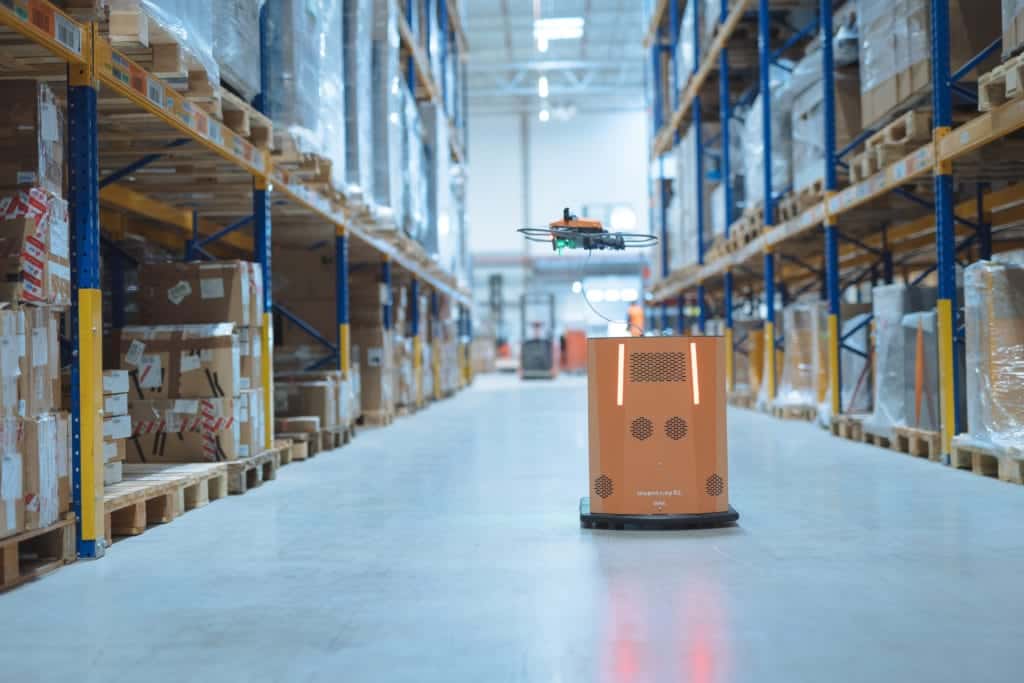How warehouse automation can enhance worker safety
It goes without saying that the safety of warehouse operatives should be the top priority for employers. As well as being a legal requirement, enhanced safety is also key to ensuring good welfare standards and staff satisfaction. Failure to focus on safety can, of course, result in damaged equipment, accidents, and even fatalities.

In short, ignoring warehouse safety can quickly lead to cost implications and legal troubles.
Fortunately, there is an answer.
Enter drone automation
Task automation can be a reliable solution to all manner of warehouse safety concerns. It not only reduces the time your staff spend working at height, but it also ensures unproductive yet business-critical tasks can be made as efficient and error-free as possible.
It also allows your workforce to focus on important or intellectually demanding tasks knowing the mundane, inefficient or even dangerous tasks are being handled.

Three automation technologies to revolutionise your warehouse
Pick-to-light: This system assists in picking the warehouse inventory in a more efficient and accurate manner than manual counts. It features LEDs near the relevant inventory, which automatically light up so the worker can scan to inform the WMS that the inventory is ‘picked’.
Pick-to-light systems save time and improve accuracy of counts, but may not be ideal for either small warehouses or ones which cannot be customised with the relevant equipment.
Automated Guided Vehicles (AGVs): Automated Guided Vehicles (or Self Guided Vehicles) are material handling systems/vehicles that automatically navigate in the warehouse to handle inventory across locations.
Advantages include increased efficiency, accuracy, and better ROI; meanwhile, a reduced dependency on labour and the AGV’s ability to handle dangerous goods means that it is safer than manual labour.
Autonomous Inventory Drones: Scanning inventory remains an important task for warehouses of all sizes and categories. Whether it is for audit purposes or to forecast demand based on the flow of goods, frequent inventory scans provide numerous benefits. This task – while important – is also repetitive, prone to human error, and is not a productive use of the workforce’s time. There are also safety concerns around manual inventory scans, with workers having to scan locations that are difficult to access.
With autonomous drones scanning the inventory, the process is faster, more accurate, and significantly safer. Furthermore, since the drones work completely autonomously, they free up staff to be redeployed to higher value, more productive duties.
In order to determine whether autonomous drones are a good fit for your warehouse, we encourage you to visit our Cost Saving Calculator to evaluate the financial benefits that the technology can bring to your business. Addressing concerns around warehouse safety in a timely and effective manner is a win-win situation for the whole business. If the warehouse workers are healthy and happy in their work, that’s reflected by a better service for end customers, which in turn is good news for the company’s reputation, as well as its financial performance.
Like what you’ve read so far? There’s lots more in our logistics whitepaper. Get your free copy at the link below.
Increased speed and efficiency
It’s not just warehouse and logistics executives who are excited by the speed and efficiency possibilities that automation brings – employees on the ground love it too. Not only did the HBR survey show great enthusiasm for technology that helps employees do their jobs faster and better, but we’ve seen it on the ground when conducting proof of concepts, too. At every warehouse we’ve been to, the amount of interest the inventAIRy XL solution generates is incredible – all from people excited to see how this clever little robot and drone combo can make their lives easier and free them from the burden of monotonous and repetitive tasks!
Higher-quality work
There’s no question that systems like inventAIRy XL is capable of conducting far more accurate inventory counts than humans. That’s not a criticism – even the best among us get hungry, tired or distracted, and mistakes can easily creep in when doing repetitive tasks that a robot will happily work through.
Our travels to warehouses have shown that, far from feeling threatened by this, workers are embracing it. No one likes feeling like they’re making mistakes at work, especially ones that will potentially prove costly, so the overwhelming feeling we received from warehouse employees was excitement that the company as a whole would be improved by the addition of some automation.
Growth opportunities
Many employees think automation naturally leads to downsizing of the workforce, but from our experience, this is overwhelmingly not the objective of our customers. Instead, they want to maximise the opportunity afforded by automation to reallocate their staff to more valuable tasks, that will improve the overall performance of the business.
We know of warehouses who have won contracts on the proviso they automate certain processes, and this is down to the cost savings, increased accuracy and environmental advantages it brings. By adding automation to their operations, 3PL providers have a differentiator that can lead to real growth – and in turn, the need for more human employees alongside the automated ones!
Takeaways for Companies
The automation of warehouse operations has the potential to make a real, positive impact on workers, and owners and employees can both enjoy the benefits that new technologies can bring.
There will of course be concerns from staff (though we’ve largely encountered positive reactions up and down the UK when demonstrating the system), but by emphasising the wins – the potential to upskill, the health & safety benefits, the ability to move staff away from repetitive, inefficient tasks – organisations should be able to ensure their team gets as excited about this as we are!
